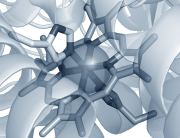General Description
The Chapman group focuses on pushing X-ray imaging beyond conventional resolution limits caused by radiation damage and technology. Short, intense X-ray pulses, from X-ray FEL sources, are used to out-run radiation damage processes. The interaction of these pulses with matter is studied, and methods of phase retrieval and coherent imaging are developed.
Henry Chapman, PhD, W3 professor. X-ray optics and imaging.
Anton Barty, PhD, Senior Scientist. Instrumentation and analysis.
Thomas White, PhD, Research Fellow. Data analysis.
Lorenzo Galli, PhD student diffraction theory and X-ray-matter interaction.
Dominik Oberthuer, PhD, postdoc nanocrystal characterisation and data analysis.
The group has key competence in X-ray optics, coherent imaging, and X-ray FEL instrumentation. The group utilizes a dedicated high-performance computer cluster for the analysis of over 20 million diffraction patterns recorded in initial LCLS experiments.
PhD supervisor: Prof. Henry Chapman
Objectives:
SO = Scientific Objectives;
TO = Training Objectives.
SO1: High-resolution X-ray structures of membrane proteins through nano-crystallography.
SO2: New phasing methods based upon high-intensity diffract-and-destroy ultrafast nano-crystallography.
TO1: Training in coherent X-ray optics, diffraction, and inverse problems
TO2: Training in the use of state-of-the-art X-ray sources.
TO3: Training in scientific computing software development.
Collaborate in the development of merging coherent nanocrystal diffraction patterns to attain accurate and complete structure factors for structure determination. Phasing method will be developed and tested on simulated and experimental data both in a structural biology context and that of atomic physics. The ESR will utilise high-performance computer clusters at DESY and take part in experiments at LCLS and other X-ray sources and be trained in X-ray diffraction analysis, coherent diffractive imaging and phase retrieval:
Involvement with other tasks: The ESR will assist others with the development of on-line diagnostics and measurement techniques for nano-crystallography and single-particle imaging.
Local Training: This ESR will be enrolled as a PhD student at the University of Hamburg as part of Graduate schools in the Department of Physics and Biochemistry. Additional training is provided by the Center for Free-Electron Laser Science, which is partner in an International Max Planck Graduate Program.
PublicationsRecent developments in CrystFEL
White T. A., Mariani V., Brehm W., Yefanov O., Barty A., Beyerlein K. R., Chervinskii F., Galli L., Gati C., Nakane T., Tolstikova A., Yamashita K., Yoon C. H., Diederichs K., and Chapman H. N.
online 29 March 2016 – DOI: https://doi.org/10.1107/s1600576716004751

ESR
Aleksandra Tolstikova
2012-2014 MSc in Applied Mathematics and Physics, Moscow Institute of Physics and Technology, Russia.
Diploma thesis: Low-dimensional organic conductors: high pressure crystal structure and electronic properties of (ET)2Cu2(CN)3 superconductor.
2008-2012 BSc in Applied Mathematics and Physics, Moscow Institute of Physics and Technology, Russia.
Main field of study: Solid-state physics
Speciality: X-ray structure analysis
Diploma thesis: Crystal structure and electronic properties of low-dimensional organic conductors (ET)8 (ReCl6)x.










